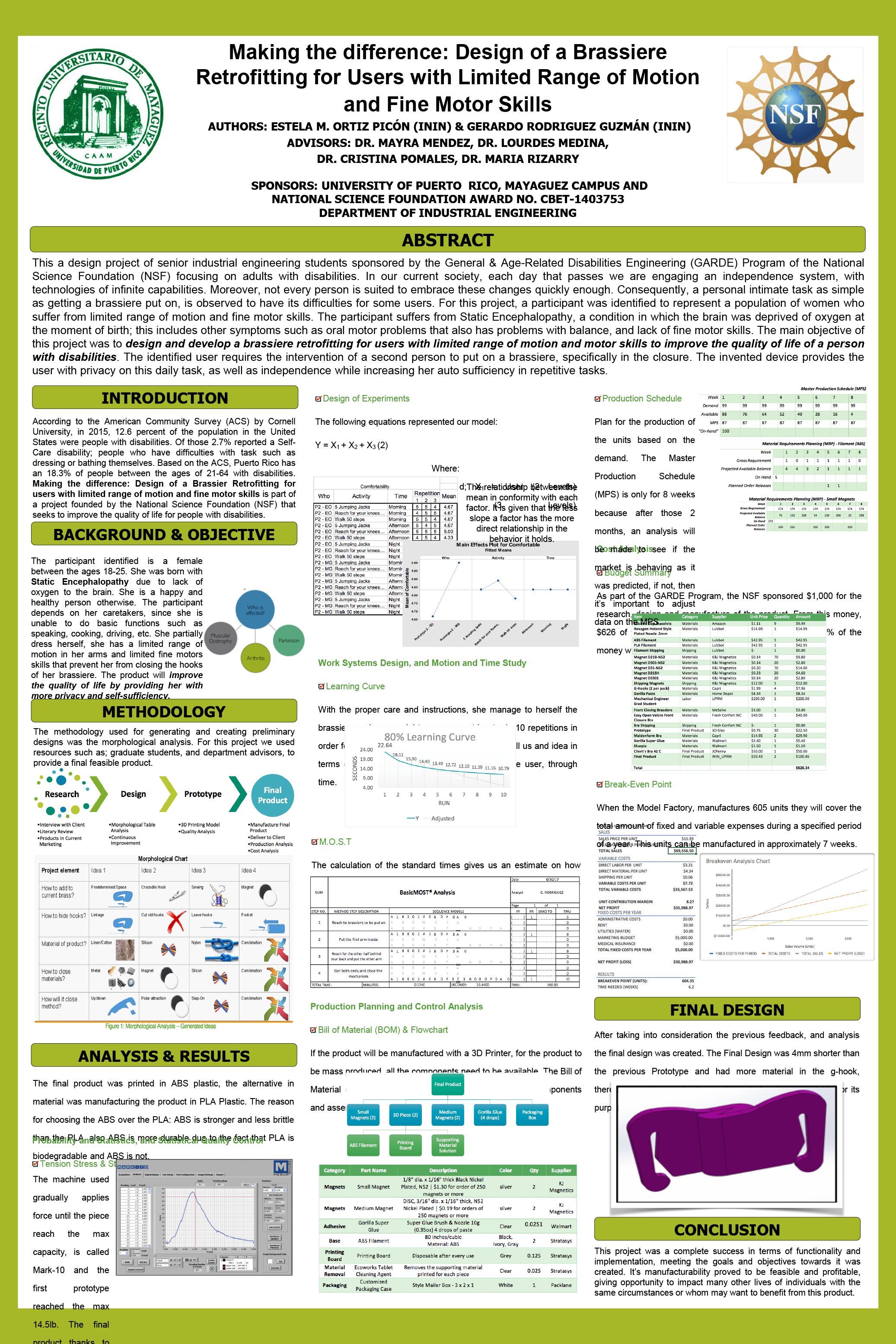Making the Difference: Brassiere retrofitting for users with limited range of motion and fine motor skills
Student Team:
Estela M. Ortiz Picón, Industrial Engineering Senior Student
Gerardo Rodríguez Guzmán, Industrial Engineering Senior Student
Faculty Mentors:
Lourdes Medina, PhD
Mayra Méndez, PhD
María Irizarry, PhD
Project Synopsis:
Making the Difference: Design of an Ergonomic Device for People with Upper Limb Prosthesis focuses on adults with disabilities. In today’s current society, with each passing day, humans engage in an independence system, with technologies of infinite capabilities. Moreover, not every person is suited to embrace these changes quickly enough. Consequently, a personal intimate task as simple as putting on a brassiere, is observed to have its difficulties for some users. For this project, a participant was identified to represent a population of women who suffer from limited range of motion and fine motor skills. The participant suffers from Static Encephalopathy, a condition in which the brain is deprived of oxygen at birth. Patients usually show symptoms such as oral-motor problems, poor balance and lack of fine motor skills. The main objective of this project was to design and develop a brassiere retrofitting for users with limited range of motion and motor skills to improve the quality of life of a person with disabilities. The identified user requires the intervention of a second person to put on a brassiere, specifically to fasten the closure. The device invented provides the user with privacy on this daily task, as well as independence while increasing her auto sufficiency in repetitive tasks.
A preliminary additive model was achieved through morphological analysis and research; this design was developed at the beginning of the process. The purpose was to start with a 3D printed device, then make a functional prototype, and finally develop a ready-to-use, deliverable final product for the user. The focus is on front-closing brassieres and the delivery of this invention was made by the end of the 2017 spring semester.
A morphological analysis methodology was used for the design, in order to provide various approaches (4 ideas) while looking through different materials and possible outcomes (3 preliminary designs). These ideas were used to develop a product model through the Work System Design, including MOST to capture the reduction in closure actions and learning curves to present the improvements of task time over number of trials.
After having manufactured the final product, a market forecast analysis was conducted, with emphasis on the current population to predict future behavior. At this moment, the production of these units and availability to reproduce was focused on applying Production Planning and Control methods.
Since the product must be reliable, an analysis of materials was conducted, considering material specifications. The product was submitted to a washing machine test, but failed. Also, another metric presented is a DOE Factorial Regression to predict what factors can affect the sensitivity of the mechanism to open, as well as user satisfaction. While ensuring it could withstand certain amount of force a tension stress test was conducted.
On the other hand, it was convenient to just identify a problem and provide a solution regardless of the incurred costs. This product has the potential to be mass produced, which is why all the economic and costs aspects were taken into account. Some of the findings were unexpected, but considering certain resources, if given the opportunity they could turn favorable. Completing the final requirement for Engineering Economics and Managerial and Cost Accounting, it can be stated that the product does not represent a security threat, but could take some toll on environmental health. Finally, and most importantly, the product was created, complying with its main purpose and functions.
This project was supported by the National Science Foundation contract CBET-1403753, “Making the Difference: An Industrial Engineering Capstone Design Experience to Benefit Adults with Disabilities.”

